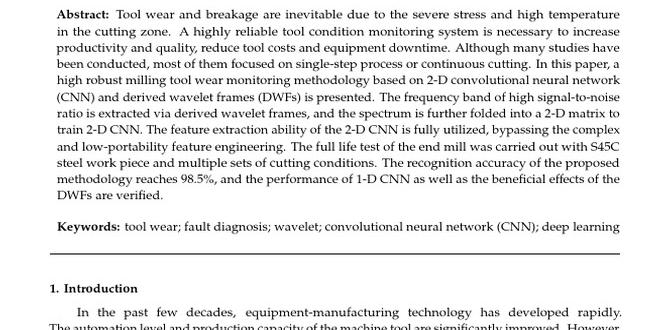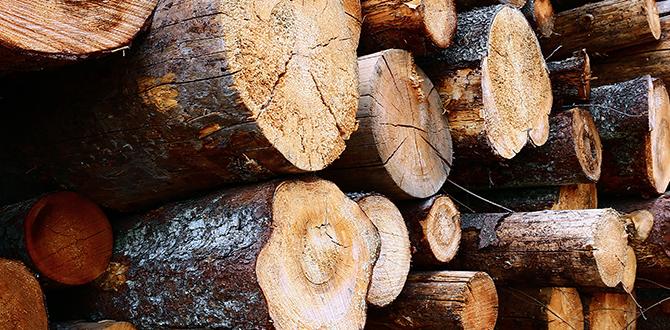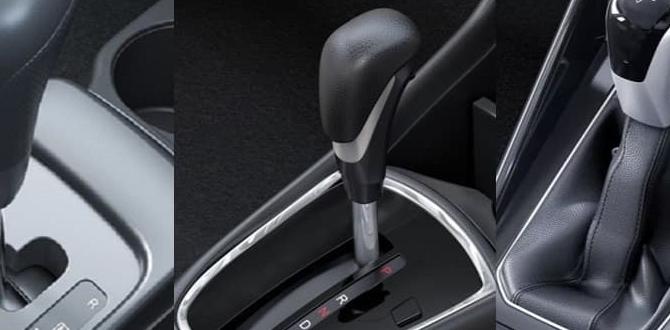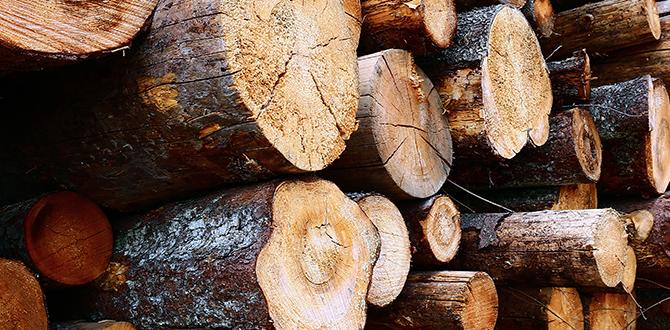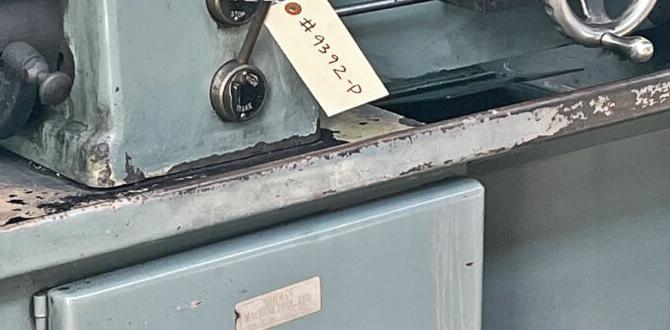Learn to avoid common wood lathe sharpening mistakes with this essential beginner’s guide, presented in a clear, step-by-step format. Master sharp tools for better woodworking and safer turning.
Welcome to Lathe Hub! Ever feel like your wood chisel just isn’t cutting the way it used to? Or maybe your lathe tools seem to be burning the wood instead of shaving it off cleanly? You’re not alone. For many of us starting out with a wood lathe, sharpening our tools can feel like a bit of a mystery. It’s one of those skills that makes a huge difference, but it’s easy to get wrong. That’s why I’ve put together this guide to help you sidestep the most common wood lathe sharpening mistakes. We’ll break it down into simple steps, so you can get back to creating beautiful pieces with confidence. Let’s dive in and make sure your tools are always razor-sharp!
Why Sharp Tools Matter for Woodturning
Having sharp tools on your wood lathe isn’t just about making pretty shavings; it’s fundamental to your success and safety. A dull tool requires more force to cut, which can lead to tear-out, uneven surfaces, and a frustrating turning experience. It also pushes the wood, creating instability and increasing the risk of kickback – a dangerous situation where the wood is violently thrown back towards you.
Sharp tools, on the other hand, glide through the wood with ease. They produce delicate shavings, leave a smooth finish that requires less sanding, and allow for more precise control over your work. This means less effort, better results, and a much safer time at the lathe.
Common Wood Lathe Sharpening Mistakes Beginners Make
Let’s talk about the pitfalls many beginners encounter when sharpening their wood lathe tools. Recognizing these mistakes is the first step to avoiding them.
1. Overheating the Tool Edge
This is arguably the most common and damaging mistake. When you grind too aggressively or for too long without cooling, the steel in your tool’s cutting edge gets too hot. This heat can literally change the molecular structure of the steel, drawing its temper and making it much softer and less able to hold a sharp edge. You might think you’ve got a sharp tool, but it will dull incredibly quickly, defeating the whole purpose.
How to avoid: Use a slow-speed grinder with plenty of water, or employ other cooling methods like dipping the tool in water frequently.
Listen for it: If you hear a hissing sound when the tool touches the grinding wheel, it’s too hot.
2. Incorrect Grinding Angle
Every wood lathe tool – whether it’s a gouge, skew chisel, or scraper – has an optimal grinding angle for effective cutting. Using the wrong angle means the tool won’t perform as intended. For example, a gouge ground too steep might dig in aggressively, while one ground too shallow will struggle to cut cleanly.
What’s the right angle? This varies by tool type and wood density. A good starting point for most general-purpose gouges is around 35-45 degrees. Skew chisels might be ground to a flatter angle for scraping cuts.
Tools to help: Many grinders have angle guides, or you can use a small angle finder.
3. Using the Wrong Sharpening Media
Not all sharpening stones or wheels are created equal. Using a stone that’s too coarse will remove too much metal and make it hard to achieve a fine edge. Using one that’s too fine might not be aggressive enough to reshape a dulled edge.
Grinding wheels: Typically, a coarse wheel (around 60-80 grit) is used for initial shaping, followed by a finer wheel (around 120-180 grit) for honing.
Water stones/Oil stones: These come in a vast range of grits, from coarse to ultra-fine. For most woodturning tools, a progression from around 1,000 grit up to 4,000 or 8,000 grit is common for a polished edge.
4. Not Achieving a True Bevel
The bevel is the angled surface that forms the cutting edge. It needs to be ground evenly and consistently. If the bevel is uneven, one side will be sharper or weaker than the other, leading to poor cutting performance and potentially causing the tool to chatter or dig in unpredictably.
How to check: Visually inspect the bevel to ensure it’s symmetrical.
Practice makes perfect: Consistent movement and pressure are key.
5. Forgetting the Hollow Grind (for Gouges)
Many woodturning gouges are intended to be ground with a “hollow grind.” This means the bevel is ground at an angle so that when you look at the tool head-on, the bevel appears slightly concave or scooped out. This shape is crucial for a gouge’s ability to sweep and cut effectively. Grinding a flat bevel on a gouge will change its cutting action dramatically and usually not for the better.
Achieving it: This is usually done by rocking the tool’s flute against the curve of a grinding wheel.
The benefit: The hollow grind reduces the contact area with the wood and makes it easier to control the cut.
6. Skipping the Honing Stage
Grinding reshapes the bevel, but it often leaves microscopic teeth and burrs on the cutting edge. Honing is the process of refining this edge using finer abrasives, removing those imperfections, and creating a razor-sharp, polished cutting surface. Skipping this step means you’ll have a tool that might be somewhat sharp but will dull very quickly and won’t cut as cleanly as it could.
What to use: Fine grit sharpening stones, diamond plates, or specialized honing compounds on leather strops.
Goal: A mirror-like finish on the bevel is what you’re aiming for.
7. Over-Stropping or Under-Stropping
Stropping is an essential part of achieving that final, keen edge. However, it’s possible to over-do it or under-do it. Over-stropping can sometimes round over the very fine edge you worked so hard to create. Under-stropping means you haven’t removed enough of the microscopic burr left by the grinding process.
Technique: Use light pressure and maintain the correct angle. Typically, a few passes on each side are sufficient.
Leather strops: Often loaded with a honing compound (like chromium oxide) which is a very fine abrasive.
Essential Tools for Wood Lathe Sharpening
To effectively sharpen your wood lathe tools and avoid common mistakes, you’ll need a few key items.
Sharpening Station Setup
A good sharpening station is crucial for consistency and safety.
Grinder:
Bench Grinder: A common choice. Opt for a model with a good motor and variable speed if possible. Using a slow-speed grinder (around 400-600 RPM) is highly recommended to prevent overheating.
Specialty Grinders: Systems like the Oneway Wolverine Grinding Jig or Diamond Pacific Grinding systems are designed specifically for turning tools and can significantly improve accuracy.
Sharpening Jigs: These are vital for holding your tools at the correct angle consistently.
Gouge grinding jigs: Help maintain the correct angle and rock the tool for a hollow grind.
Skew chisel jigs: Ensure a symmetrical bevel on these often-tricky tools.
Water Trough/Coolant System: Essential for keeping grinding wheels cool. Many grinders have attachments for this.
Wheel Dresser: Used to true up and clean your grinding wheels, ensuring a flat and effective grinding surface. A diamond dresser is standard.
Sharpening Media
After grinding, you’ll need finer media to refine the edge.
Honing Stones:
Water Stones: Come in a vast range of grits and are excellent for achieving a razor-sharp edge. They require soaking before use. Look for sets that go from around 1000 grit up to 4000 or 8000 grit.
Diamond Plates: Durable and fast-cutting, they don’t require soaking and are available in a wide spectrum of grits.
Leather Strop: A piece of leather, often mounted on a flat surface, used with a honing compound. This is the final step to polish the edge and remove any last remnants of a burr.
Honing Compound: A fine abrasive paste (e.g., chromium oxide, diamond paste) applied to the strop to enhance its polishing capability.
Measuring and Marking Tools
Angle Gauge/Protractor: To verify your grinding angle.
Marker Pen: To mark the bevel during sharpening to ensure full coverage.
Step-by-Step Guide: Sharpening Common Wood Lathe Tools
Let’s walk through sharpening some of the most common tools you’ll use on a wood lathe.
1. Sharpening a Bowl Gouge
Bowl gouges are used for everything from roughing out bowls to creating fine details. Achieving the correct “swept-back” grind and hollow grind is important.
Tools Needed:
Slow-speed grinder with water trough
Gouge grinding jig
Diamond wheel dresser
Water stones or diamond plates (e.g., 1000, 4000, 8000 grit)
Leather strop with honing compound
Angle gauge
Marker pen
Steps:
- Prepare Your Grinder: Ensure your grinder is fitted with appropriate grinding wheels. A standard white aluminum oxide wheel is good for high-speed steel (HSS). Use a wheel dresser to ensure the wheel is flat and clean. If using a water-cooled grinder, fill the trough.
- Set Up Your Jig: Mount the gouge grinding jig to your grinder. Consult your jig’s instructions for setting the correct angle. For a standard bowl gouge, aim for a bevel angle of around 35-45 degrees. The jig will guide the angle of the tool as you rock it.
- Mark the Bevel: Use a marker pen to color the bevel area of the gouge. This will help you see where the grinding wheel is making contact and ensure you’re grinding the entire bevel without overheating one spot.
- Position the Gouge: Place the gouge into the jig. The flute of the gouge should be positioned so that as you rock it, it forms a hollow grind. The cutting edge should be presented to the grinding wheel at the desired angle.
- Grind the First Side: With the grinder running, gently bring the gouge to the wheel. Rock the tool from side to side in a controlled motion, keeping the bevel in contact with the wheel. Grind until the marker ink is removed from the bevel. Be mindful of heat; if the tool feels hot to the touch or you hear significant hissing, stop and cool it in water. A few seconds of grinding followed by cooling is better than one long, overheated session.
- Grind the Second Side: Rotate the jig or tool to grind the opposite side of the bevel. Again, grind until the ink is removed. Aim for symmetry between the two sides. You want the nose of the gouge to be sharp and the bevel uniform.
- Check the Bevel: Inspect the ground bevel. It should be free of the marker ink and have a consistent, secondary bevel forming the hollow grind. Don’t over-grind; remove only what is necessary to restore the edge.
- Hone the Edge: Move to your water stones or diamond plates. Start with a medium grit (e.g., 1000). Hold the gouge at the same angle used for grinding and hone the bevel. Use a gentle, sweeping motion over the stone. Alternate sides or work one side at a time, focusing on removing the burr left by the grinder.
- Refine with Finer Grits: Progress through your finer grit stones or plates (e.g., 4000, 8000). Hone each side of the bevel until it feels smooth and sharp. You should start to feel a slight “wire edge” or burr forming on the opposite side of the bevel as you hone.
- Strop for the Final Edge: Take your leather strop loaded with honing compound. Place the tool on the strop with the bevel flat against the leather (maintaining the grinding angle is key). Make light, back-and-forth passes, alternating sides, or lift the tool and stroke away from the edge. A few passes per side are usually enough. The goal is to remove the fine burr and polish the edge to a mirror finish.
- Test sharpness: You can carefully test the sharpness by trying to shave a thin curl off a piece of soft wood. A truly sharp tool will do this easily with minimal pressure.
2. Sharpening a Skew Chisel
The skew chisel is a versatile tool for finishing cuts, planing surfaces, and creating beads. Its bevels require precision.
Tools Needed:
Slow-speed grinder with water trough
Skew chisel jig (or a freehand technique if very experienced)
Water stones or diamond plates
Leather strop with honing compound
Marker pen
Steps:
- Prepare Grinder and Jig: Set up your grinder as you would for the gouge. Skew chisel jigs are designed to hold the tool at the correct angle and allow you to move it across the wheel to grind the entire bevel face, not just the very tip.
- Mark the Bevel: Color the bevels on both sides of the skew with your marker pen.
- Set Grinding Angle: For most skew chisels, the primary bevel angle is around 20-30 degrees, with a secondary bevel making the total cutting angle slightly steeper. Consult your jig or tool manufacturer’s recommendations. The jig will help maintain this angle.
- Grind the Bevels: Present the skew to the grinding wheel, maintaining contact with the bevel. Move the tool in and out of the wheel in a controlled manner, ensuring the entire bevel face is ground evenly. Grind one side until the ink is removed, then switch to the other side of the tool and repeat. Again, cool the tool frequently to prevent overheating.
- Check Symmetry: Inspect both sides of the bevel. They should be ground evenly and meet at the cutting edge to form a sharp point. The typical method for sharpening a skew is to grind both bevels flat, not hollow.
- Hone and Strop: Progress through your sharpening stones/plates, honing each bevel. For the skew, you’ll often want to alternate between honing the primary and secondary bevels. Finally, strop both sides of the cutting edge on your leather strop with compound. The goal is a perfectly straight, sharp edge.
3. Sharpening Scrapers
Scrapers are used for fine finishing, often on end grain or for removing tool marks. They don’t get ground like chisels; they get “sharpened” by creating a tiny burr or “hook” at the edge.
Tools Needed:
Fine grit sharpening stone or diamond plate (e.g., 4000 grit or higher)
Burnisher tool (steel or carbide)
Pliers or a vise for holding the scraper
Steps:
- Flatten the Face: First, use a fine grit stone or diamond plate to ensure the scraping face is perfectly flat and smooth. This removes any nicks or previous burrs and prepares the surface.
- The Burnishing Process: Hold the scraper firmly with pliers or place it in a vise. Take your burnisher tool and place its rounded edge against the scraping edge, at about a 45-degree angle. Apply firm pressure and draw the burnisher along the entire length of the scraping edge. You are essentially bending a tiny lip of metal over to create a hook.
- Repeat on the Other Side: Flip the scraper over (if it has a second working edge) and repeat the burnishing process. You want to create this tiny burr on both sides if the scraper is designed for it.
- Test the Cut: A properly burnished scraper will produce very fine, almost powdery shavings or “dust” when used on the lathe with a scraping action. If it’s not cutting, you may need to burnish harder or move the burnisher at a slightly different angle.
Understanding Your Tool Steel
Most high-quality woodturning tools are made from High-Speed Steel (HSS). HSS is designed to retain its hardness even when heated to high temperatures by friction, which is common during cutting. However, it has its limits. Overheating during grinding or prolonged cutting with a dull tool can still degrade the HSS.
Some premium tools might useatorias or other specialized alloys, which can offer even better edge retention and toughness, but they still require careful sharpening to avoid overheating. Always try to identify the type of steel your tools are made from, as it can influence the best sharpening methods and media for them

